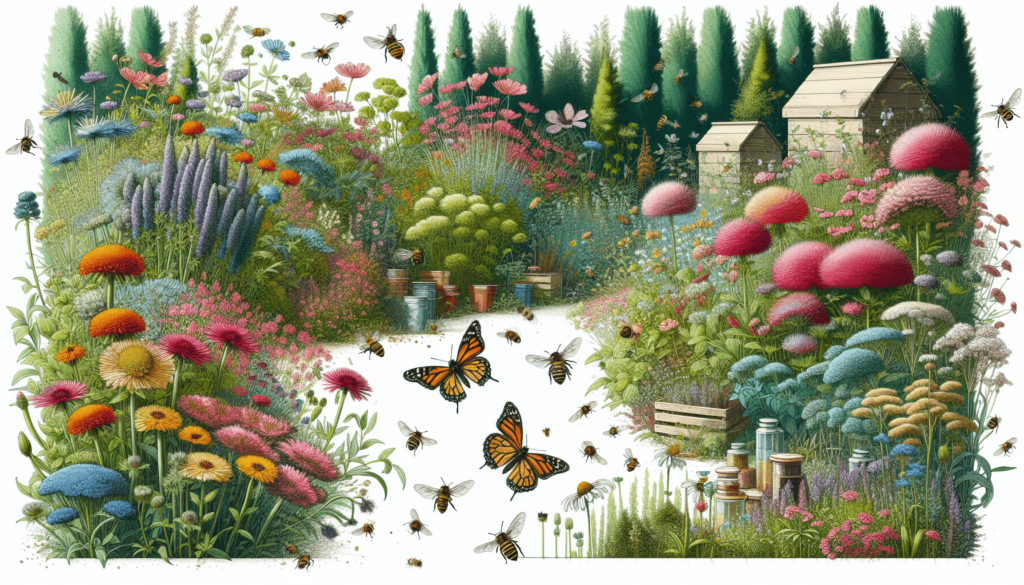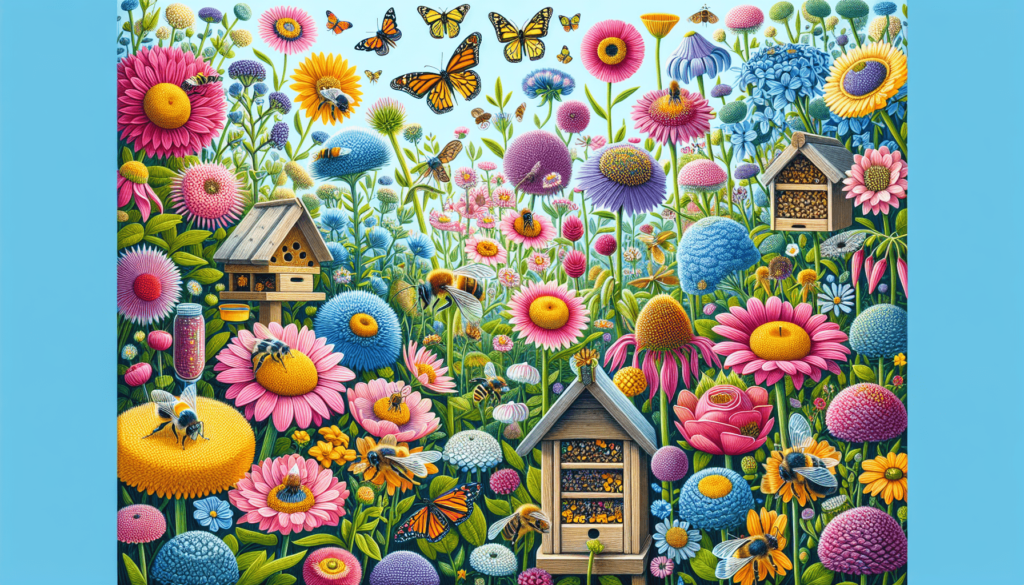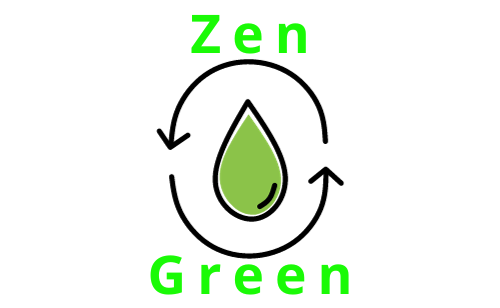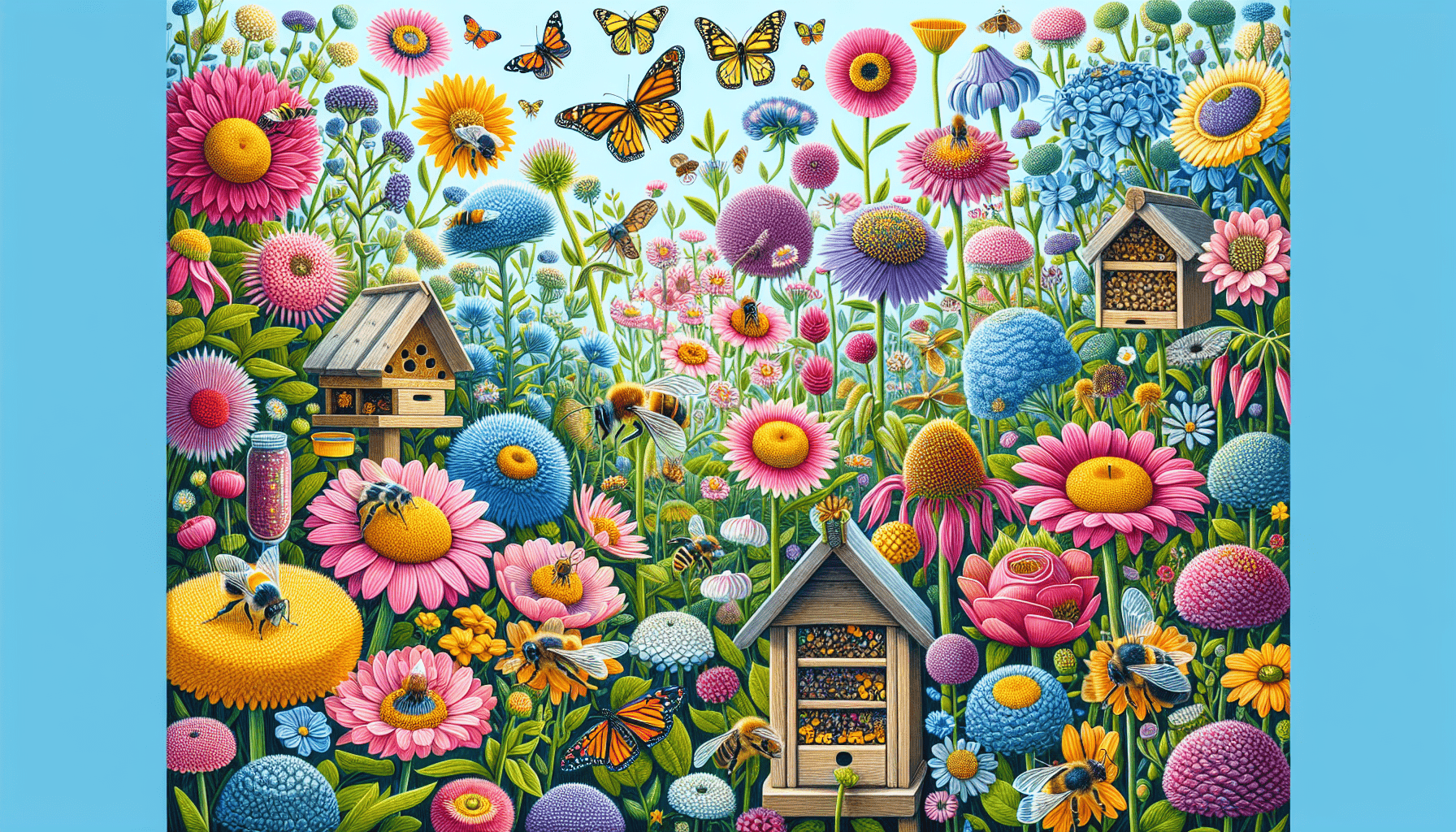Imagine having a garden filled with vibrant colors and buzzing sounds, where butterflies and bees gracefully dance from flower to flower. Creating a pollinator-friendly garden is not only a visually stunning addition to your outdoor space, but it also plays a crucial role in supporting the declining population of these essential creatures. In this article, you will discover simple yet effective ways to transform your garden into a haven that attracts and nourishes pollinators, ensuring their well-being and the beauty of your surroundings.
Choose Native Plants
When creating a pollinator-friendly garden, one of the most important steps is to choose native plants. Native plants are the best choice because they have evolved alongside native pollinators and provide them with the necessary food and habitat. To select the right native plants for your area, it is important to do some research. Look for resources online or visit your local nursery to find out which plants are native to your region. Consider factors such as climate, soil type, and available space when making your selections. By choosing native plants, you will not only attract a diverse array of pollinators but also support the overall ecological health of your garden.
Research Native Plants in Your Area
Before purchasing any plants, it is crucial to research native plants that are suitable for your specific region. Different areas have unique environmental conditions, and by selecting plants that are native to your area, you can ensure their success in your garden. Spend some time familiarizing yourself with the different native plants that grow well in your region. Look for information about their growth habits, bloom times, and preferred growing conditions. This knowledge will help you make informed decisions when creating your pollinator-friendly garden.
Select a Variety of Flower Shapes and Colors
When it comes to attracting pollinators, diversity is key. Pollinators have different preferences for flower shapes and colors, so it is important to provide a variety of options in your garden. Choose flowers with different shapes, such as tubular, bell-shaped, or flat. This will attract different types of pollinators, each with their own specific feeding adaptations. Additionally, consider selecting flowers in a range of colors, including yellows, blues, purples, and whites. By offering a wide selection of flower shapes and colors, you will create a vibrant and enticing garden that appeals to a wide range of pollinators.
Plant in Clumps of the Same Species
When planting native flowers in your garden, it is beneficial to group them in clumps. Clumping native plants together creates a more impactful visual display and enhances their attractiveness to pollinators. By planting in clumps, you are providing a concentrated nectar and pollen source for pollinators, making it easier for them to locate and access their food. This clustering of flowers also mimics natural plant communities, which is more appealing to native pollinators. Additionally, planting in clumps helps ensure cross-pollination between the same species, which is crucial for their long-term survival and genetic diversity.
Provide a Water Source
In addition to food sources, pollinators also require a water source for survival. By including a water feature in your garden, you can create an attractive and functional space for pollinators to drink and cool off. A shallow birdbath or saucer filled with clean water is an excellent option for providing a water source. It is important to keep the water fresh and clean, regularly changing it to prevent the growth of algae or bacteria. To make your water source even more inviting, consider adding rocks or small logs to create landing spots for pollinators. This will provide them with a safe and secure place to rest while they drink.
Use a Shallow Birdbath or Saucer
When selecting a water source for your pollinator-friendly garden, opt for a shallow birdbath or saucer. Pollinators, especially bees, are not strong swimmers and can easily drown in deep water. To ensure their safety, choose a water source that is no more than 2 inches deep. This will allow them to drink and cool off without the risk of drowning. Avoid birdbaths with slippery surfaces, as this can make it difficult for pollinators to land and access the water. A shallow saucer filled with water and placed on the ground or on a low pedestal is an ideal option for providing a safe and accessible water source.
Keep the Water Fresh
To make your water source inviting and beneficial for pollinators, it is important to keep the water clean and fresh. Pollinators are attracted to clean water sources and may avoid stagnant or dirty water. Change the water in your birdbath or saucer every few days to prevent the growth of algae or bacteria. Cleaning the water source regularly will ensure that pollinators have access to fresh and safe water, promoting their health and well-being. Additionally, consider placing your water source in a shaded area to prevent it from becoming too hot and potentially harming pollinators.
Add Rocks or Small Logs for Landing Spots
When designing your water feature, consider adding rocks or small logs to create landing spots for pollinators. These landing spots provide a stable and secure surface for pollinators to rest on while they drink. Bees, in particular, benefit from landing spots as they often need to rest and warm up before taking flight again. By adding rocks or logs to your water source, you are creating a welcoming environment for pollinators to drink, rest, and recharge. Ensure that the rocks or logs are easily accessible and not submerged in the water, allowing pollinators to land and easily access the water.
Avoid Chemical Pesticides and Herbicides
In a pollinator-friendly garden, it is essential to avoid using chemical pesticides and herbicides. These synthetic chemicals can be harmful to pollinators, killing or impairing them when they come into contact with treated plants. Instead, opt for organic pest control methods that are safe for both pollinators and the environment. There are numerous organic pest control options available, including insecticidal soaps, neem oil, and beneficial insects. These methods target specific pests, minimizing the impact on pollinators. By avoiding chemical pesticides and herbicides, you are creating a safe and healthy environment for pollinators to thrive.
Use Organic Pest Control Methods
When dealing with pests in your garden, it is important to use organic pest control methods. By using organic pest control methods, you can effectively manage pests while minimizing harm to pollinators. Insecticidal soaps, for example, are an effective option for controlling aphids and other soft-bodied insects. Neem oil is another organic pest control method that targets a wide range of garden pests, including aphids, beetles, and caterpillars. Additionally, consider introducing beneficial insects to your garden, such as ladybugs and lacewings, as they can help control pest populations naturally. By choosing organic pest control methods, you are prioritizing the health and well-being of pollinators in your garden.

Encourage Beneficial Insects
In a pollinator-friendly garden, it is important to encourage beneficial insects. Beneficial insects play a crucial role in maintaining a healthy ecosystem and helping control pest populations naturally. Ladybugs, lacewings, and hoverflies are just a few examples of beneficial insects that help control garden pests. To attract these beneficial insects, provide them with the necessary habitats and food sources. Incorporate a diverse range of plants that produce pollen and nectar throughout the season. Additionally, consider leaving areas of bare ground or patches of loose soil for ground-nesting bees to create their nests. By encouraging beneficial insects, you are promoting a balanced and thriving garden ecosystem.
Handpick Pests If Necessary
In some instances, pest populations may become too large to manage solely with organic pest control methods. In these cases, handpicking pests can be an effective and environmentally friendly solution. Inspect your plants regularly and manually remove pests such as caterpillars, slugs, or beetles. Wear gloves and carefully pick off the pests, either dropping them into a bucket of soapy water or relocating them away from your garden. By actively managing pest populations through handpicking, you can reduce the need for chemical pesticides and minimize harm to pollinators. This hands-on approach allows you to address specific pest issues while maintaining a safe and welcoming environment for pollinators.
Plant Flowers with Different Blooming Times
To provide a continuous source of nectar and pollen throughout the growing season, it is important to plant flowers with different blooming times in your garden. By selecting a mix of early, mid, and late-season plants, you can ensure that there is always something in bloom for pollinators to feed on. Early-season plants, such as crocuses and snowdrops, provide much-needed resources for pollinators emerging from hibernation. Mid-season plants, such as coneflowers and bee balm, offer a plentiful supply of nectar and pollen during the peak of the summer. Late-season plants, such as asters and goldenrods, provide a critical food source as pollinators prepare for winter. By planting a diverse range of flowering plants, you can support pollinators throughout the entire season.
Choose Early, Mid, and Late-Season Plants
When selecting plants for your pollinator-friendly garden, aim to include a mix of early, mid, and late-season plants. Early-season plants bloom in the spring and provide much-needed resources as pollinators emerge from hibernation. These plants often have bright flowers that are rich in nectar and pollen. Mid-season plants bloom from late spring to early summer and offer a continuous source of food for pollinators during the peak of the season. Late-season plants, on the other hand, bloom in late summer and fall when other food sources may be scarce. By including plants from each blooming period, you ensure that pollinators have access to nectar and pollen throughout the entire growing season.
Ensure Continuous Nectar Availability
To support and attract pollinators, it is important to ensure a continuous availability of nectar in your garden. Nectar is the primary food source for many pollinators, providing them with the energy they need to fly and reproduce. By selecting a variety of flowering plants with staggered bloom times, you can ensure that there is always a source of nectar available. This continuous nectar availability is vital for supporting pollinators, especially during times when other food sources may be scarce. By designing your garden to provide a steady supply of nectar, you create a habitat that is attractive and beneficial to a diverse array of pollinators.
Create Nesting Sites
In addition to food sources, pollinators also require suitable nesting sites for their survival and reproduction. By creating nesting sites in your garden, you can provide a welcoming habitat for native bees and other pollinators. Ground-nesting bees, for example, rely on patches of bare ground or loose soil to construct their nests. Leaving areas of your garden bare or adding patches of loose soil can provide nesting opportunities for these important pollinators. Additionally, consider adding bee houses or nesting boxes to offer shelter and nesting sites for bees and other beneficial insects. Fallen leaves and dead wood can also provide habitat for nesting bees and other pollinators. By creating nesting sites, you are supporting the reproductive success and long-term survival of pollinators in your garden.
Leave Bare Ground or Patches of Loose Soil for Ground Nesting Bees
To accommodate ground-nesting bees, it is important to leave areas of your garden bare or create patches of loose soil. Ground-nesting bees, such as sweat bees and mining bees, construct their nests in the ground. By leaving areas of bare ground or creating patches of loose soil, you provide suitable nesting opportunities for these bees. Make sure the soil is not compacted and is easy for the bees to burrow into. By leaving bare ground or providing patches of loose soil, you are creating a welcoming habitat for ground-nesting bees and promoting their population growth in your garden.
Provide Bee Houses or Nesting Boxes
Another way to create nesting sites for bees and other beneficial insects is by providing bee houses or nesting boxes. Bee houses are man-made structures that mimic the natural nesting sites of bees. They often consist of a wooden frame with hollow tubes or drilled holes that serve as individual bee nesting chambers. These houses are particularly beneficial for cavity-nesting bees such as mason bees and leafcutter bees. Nesting boxes, on the other hand, are typically used by birds but can also serve as nesting sites for certain bees and wasps. By providing bee houses or nesting boxes in your garden, you can support the nesting and reproduction of these essential pollinators.
Add Fallen Leaves and Dead Wood for Habitat
To enhance the overall habitat in your pollinator-friendly garden, consider incorporating fallen leaves and dead wood. Fallen leaves provide organic matter and habitat for small insects that pollinators rely on for food. They also provide shelter for overwintering pollinators, such as butterflies and beetles. Dead wood, such as logs or branches, can also serve as important habitat for certain pollinators, including solitary bees and beetles. These decaying materials create a naturalistic and diverse environment that supports a variety of pollinators. By incorporating fallen leaves and dead wood into your garden, you are providing valuable habitat and resources for pollinators to thrive.
Research Native Host Plants for Butterflies
Butterflies are not only beautiful pollinators but also have specific host plant requirements for their caterpillars. Host plants are the plants that butterfly caterpillars eat and depend on for their survival. Different butterfly species have different host plant preferences, so it is important to research and include native host plants in your garden. Native host plants provide the necessary food and habitat for butterflies to lay eggs and for caterpillars to feed and grow. By incorporating host plants into your garden, you can attract and support a diverse range of butterfly species and contribute to their conservation.

Plant Enough to Sustain Caterpillars
When including host plants in your pollinator-friendly garden, it is important to plant enough to sustain caterpillars. Butterfly caterpillars have a voracious appetite and can consume large quantities of foliage. Planting a few host plants may not be enough to support a healthy population of caterpillars. Consider planting host plants in clusters or groups to maximize their availability and increase the chances of successful caterpillar rearing. This abundance of host plants ensures that there is enough food for caterpillars, increasing their chances of survival and successful metamorphosis into adult butterflies. By planting enough host plants, you are providing the necessary resources for butterfly conservation in your garden.
Accept Some Leaf Damage
When including host plants in your garden, it is important to accept some leaf damage. Butterfly caterpillars need to feed on the foliage of host plants in order to grow and develop. As a result, it is natural for host plants to show signs of feeding, such as chewed leaves or holes. Instead of viewing this damage as a negative, embrace it as a sign that your garden is supporting a healthy population of butterflies. Rest assured that the damage is temporary and the plants will recover. By accepting some leaf damage, you are creating a truly supportive habitat for butterflies and their caterpillars in your garden.
Select Flowers with Exposed Stamen and Pistils
When choosing flowers for your pollinator-friendly garden, look for those with exposed stamen and pistils. Stamen are the male reproductive organs of flowers, which produce pollen, while pistils are the female reproductive organs that receive pollen and produce seeds. Flowers with exposed stamen and pistils make it easier for pollinators to access the pollen and nectar. Avoid flowers with double or triple petals, which can make it more difficult for pollinators to reach the reproductive organs. By selecting flowers with exposed stamen and pistils, you are ensuring that pollinators can easily access the vital resources they need.
Avoid Double or Triple Petal Flowers
While flowers with double or triple petals may be visually appealing to us, they are not as attractive or accessible to pollinators. Double or triple petal flowers often have reduced or modified reproductive structures, making it difficult for pollinators to access pollen and nectar. Additionally, the complexity of these flowers can make it more challenging for pollinators to navigate and efficiently extract resources. Instead, opt for flowers with a single layer of petals or those that have prominent stamen and pistils. These simpler flower structures are more inviting and accommodating to pollinators, increasing their chances of successful pollination and seed production.
Ensure Easy Access to Nectar
When selecting flowers for your pollinator-friendly garden, it is important to ensure easy access to nectar. Nectar is the primary food source for many pollinators, and easy access to it is crucial for their survival and energy requirements. Look for flowers with open or shallow throats that allow pollinators to easily reach the nectar. Flowers with tubular or bell-shaped structures are often favored by pollinators such as hummingbirds and certain bees. Avoid flowers with long, narrow throats that may restrict access to nectar. By choosing flowers that provide easy access to nectar, you are creating a garden that is welcoming and supportive of a variety of pollinators.
Most Pollinators Prefer Full Sun
When it comes to creating a pollinator-friendly garden, it is important to choose a sunny location. Most pollinators, including bees, butterflies, and hummingbirds, prefer areas that receive full sun. Full sun exposure provides the warmth and light that these pollinators need to thrive and carry out their important work. When selecting a location for your garden, look for areas that receive at least 6 hours of direct sunlight per day. This will ensure that your pollinator-friendly plants have optimal growing conditions and maximize their attractiveness to pollinators. By choosing a sunny location, you are creating an inviting and productive habitat for a wide range of pollinators.
Ensure at Least 6 Hours of Sunlight
To ensure the success of your pollinator-friendly garden, it is important to provide at least 6 hours of sunlight each day. Sunlight is crucial for photosynthesis, the process by which plants convert sunlight into energy. By ensuring that your garden receives sufficient sunlight, you are providing your pollinator-friendly plants with the energy they need to grow, flower, and produce nectar and pollen. Consider the orientation of your garden and choose a location that receives the most sunlight throughout the day. Remove any obstructions such as overhanging branches or structures that may block sunlight. By ensuring at least 6 hours of sunlight, you are creating a thriving and productive garden for pollinators.
Create Partial Shade in Hotter Regions
While most pollinators prefer full sun, it is important to create partial shade in hotter regions. In areas with intense heat and sun exposure, some pollinators may benefit from a break from the midday sun. Consider incorporating elements such as trees, shrubs, or trellises to provide shade and create pockets of cooler, more sheltered areas in your garden. These shaded spots can serve as resting places for pollinators to escape the heat and recharge. Additionally, partial shade can also prolong the bloom time of certain flowers that may be sensitive to direct sunlight. By creating partial shade in hotter regions, you are providing a more hospitable environment for pollinators and helping them cope with extreme temperatures.
Plant Shrubs or Erect Fences as Windbreaks
In order to create a welcoming environment for pollinators, it is important to provide windbreaks and sheltered areas in your garden. Strong winds can make it difficult for pollinators to fly and access food sources. Consider planting shrubs or erecting fences to create windbreaks and protect vulnerable plants and pollinators from strong gusts. These barriers can also create microclimates, reducing the impact of harsh weather conditions on your garden. By providing windbreaks and sheltered areas, you are ensuring that your pollinator-friendly garden remains a safe and stable habitat for pollinators to thrive.
Provide Sheltered Spots for Resting and Overwintering
Aside from windbreaks, it is important to provide sheltered spots for resting and overwintering in your pollinator-friendly garden. Pollinators need safe places to rest, hide from predators, and seek refuge from harsh weather conditions. Incorporate elements such as dense shrubs, tall grasses, or rock piles to provide sheltered areas in your garden. These spots can serve as important resting places for pollinators, allowing them to conserve energy and recharge. Additionally, certain pollinators, such as butterflies and solitary bees, also rely on specific overwintering sites. By providing these sheltered spots, you are creating a haven for pollinators throughout the year, supporting their survival and overall health.
Create a Microclimate for Delicate Species
In a pollinator-friendly garden, it is important to consider the needs of delicate or sensitive species. Certain pollinators, such as certain butterflies or moths, may have specific microclimate requirements for their survival. These species may prefer slightly cooler or more sheltered conditions than other pollinators. To accommodate these delicate species, consider creating microclimate conditions in your garden. This can be achieved by planting in shaded or protected areas, incorporating water features to lower temperatures, or using mulch to retain moisture. By creating a microclimate for delicate species, you are providing a specialized habitat that supports their unique needs.
Incorporate a Variety of Plant Heights and Structures
When designing your pollinator-friendly garden, it is important to incorporate a variety of plant heights and structures. Different pollinators have different preferences for food sources and nesting sites. By including plants of varied heights, from low-growing ground covers to tall flowering perennials, you provide diverse habitats and foraging opportunities for a wide range of pollinators. Additionally, consider incorporating different plant structures such as shrubs, vines, and grasses. These varied structures create a multi-layered and visually appealing garden that enhances its attractiveness and functionality for pollinators.
Include Different Flower Types and Colors
To maximize the diversity of pollinators that you attract to your garden, include different flower types and colors. Pollinators have varying preferences when it comes to flower shapes and colors. By offering a wide selection of flower types, such as daisies, sunflowers, and lilies, you can cater to the preferences of different pollinator species. Similarly, including flowers in a variety of colors, including yellows, blues, purples, and whites, will attract a greater diversity of pollinators. This vibrant mix of flower types and colors creates an inviting and enticing garden that appeals to a wide range of pollinators.
Offer Habitats for Various Pollinators
To create a truly inclusive pollinator-friendly garden, it is important to offer habitats for various pollinators. Different pollinator species have different nesting and foraging requirements. By incorporating a variety of vegetation types, such as flowering plants, grasses, and shrubs, you provide diverse habitats and resources for pollinators. Additionally, consider incorporating elements such as water features, rocks, and fallen logs to create additional habitat niches. These features provide shelter, resting places, and breeding sites for a variety of pollinators. By offering habitats for various pollinators, you are creating a garden that supports a rich and diverse community of these essential creatures.
By following these guidelines and incorporating the suggested strategies, you can create a truly welcoming and productive pollinator-friendly garden. By choosing native plants, providing a water source, avoiding chemical pesticides and herbicides, planting flowers with different blooming times, creating nesting sites, including host plants for butterfly caterpillars, selecting open flowers, choosing a sunny location, creating windbreaks and sheltered areas, maintaining a diverse landscape, and offering habitats for various pollinators, you are creating an ideal environment for pollinators to thrive and contribute to the health of our ecosystems. So start planning your pollinator-friendly garden today and enjoy the beauty and benefits it will bring to your life and the world around you. Happy gardening!

